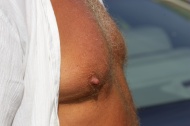Acne Scar | Age Spots | Anal Tag | Cellulite | Dropping Eyelids | Gynecomastia | Nail Fungus | Rosacea | Skin Lesion | Spider Veins | Stretch Marks | Tattoo | Wrinkle
 Gynecomastia (male breast enlargement), is the presence of enlarged, over-developed breasts in men and is common in men of any age. It can be the result of hormonal changes, heredity conditions, disease, or the use of certain drugs. Gynecomastia can cause emotional discomfort and impair your self confidence. Some men may even avoid certain physical activities and intimacy simply to hide their condition. Male breast reduction or gynecomastia reduction surgery is a treatment for gynecomastia and is the fifth most common plastic surgery procedure performed on men in the United States. This procedure is steadily gaining popularity due to public education about the condition and increasing receptiveness to treatment.
Gynecomastia (male breast enlargement), is the presence of enlarged, over-developed breasts in men and is common in men of any age. It can be the result of hormonal changes, heredity conditions, disease, or the use of certain drugs. Gynecomastia can cause emotional discomfort and impair your self confidence. Some men may even avoid certain physical activities and intimacy simply to hide their condition. Male breast reduction or gynecomastia reduction surgery is a treatment for gynecomastia and is the fifth most common plastic surgery procedure performed on men in the United States. This procedure is steadily gaining popularity due to public education about the condition and increasing receptiveness to treatment.
Gynecomastia is characterized by:
- Excess localized fat
- Excess glandular tissue development
- A combination of both excess fat and glandular tissue
- Gynecomastia may be present unilaterally (one breast) or bilaterally (both breasts)
Causes of Gynecomastia:
- Hormonal: Hormones are the primary cause of gynecomastia. It usually starts to appear at puberty as hormone levels surge to new levels with the onset of physical maturity. Testosterone develops male characteristics while estrogen brings on female traits. Low testosterone or high estrogen levels in males can allow development of female-like breast tissue or gynecomastia. Although rare, male breast enlargement can also be stimulated by hormone-secreting tumors. As men approach their sixties, naturally decreasing testosterone levels can also result in breast development.
- Drugs: Gynecomastia can also be caused by use of certain drugs, especially steroids, but also many other medications, as well.
- Weight Gain: Pseudogynecomastia is not true gynecomastia. This is a condition in which fatty tissue is responsible for the enlargement. This is seen in men who have had significant weight gain. Pseudogynecomastia can be reversed with weight loss if the skin has not been overly stretched.
Treatment for Gynecomastia:
Fortunately, the surgical treatment of gynecomastia is highly effective, giving excellent esthetic results. The treatment of choice is liposuction to the area. It might also be necessary to do liposuction along with surgical excision of the glandular tissue to achieve the best results and the flattest chest. The gland is excised through a half-inch to one-inch long incision around the edge of areola.
Is Surgical Right for Me?
Gynecomastia surgery is a highly individualized procedure and you should do it for yourself, not to fulfill someone else’s desires or to try to fit any sort of ideal image.
This procedure is a good option for you if:
- Healthy individuals who do not have a life-threatening illness or medical conditions that can impair healing and a relatively normal weight
- Your breast development has stabilized
- You are bothered by the feeling that your breasts are too large
- Adolescents may benefit from surgery, although secondary procedures may be needed in the future should breast development continue.
- Men whose condition cannot be corrected through alternative medical treatments
- Non-smokers and non-drug users
After Surgery:
Following surgery, one can drive a car in two to three days, return to work in three to five days, but not exercise the chest for four to six weeks. It is also imperative to wear a compression garment for four weeks after the procedure.






